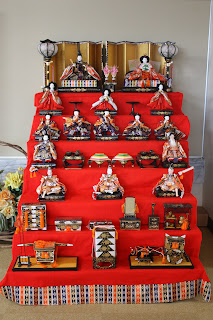Hinamatsuri (Girls' Festival, also known as Dolls' Festival) and formally called Momonosekku (Peach Festival) occurs on March 3rd and is an occasion to pray for young girls' health and growth, good marriages, and happiness. Homes with girls as well as schools display dolls for the festival and dedicate to them peach blossoms, rice cake cubes, hishimochi (special colored diamond-shaped rice cakes), shirozake (sweet white sake), and other items. Leaving the hina display out too long is said to delay marriage. So it is customary to put them away soon after March 3rd.
The origin of the hinamatsuri is an ancient Chinese practice in which the sins of the body and misfortune are transferred to a doll and washed away by setting the doll in a river to drift away. When this practice spread to Japan, it was linked to girls playing with dolls and in the Edo Period (1603-1867) was developed into the hinamatsuri. Originally, the dolls were made of paper. Today, the dolls and the displays are quite intricate and can cost upward of 330,000 JPY (over 4,000 USD using today's exchange rate) for a seven-tiered display, such as shown in the top picture, which contains (from top platform to bottom platform) the emperor and empress, three court ladies, five musicians with different instruments, two guardians with hishimochi, three fellows, the bride's dowry, and transportation and obento boxes. The emperor and the empress alone can cost 85,000 JPY (over 1,000 USD).
To learn about this traditional aspect of Japanese culture, two friends and I attended an international communication society event. There we made our own origami hina dolls and ate hinamatsuri cuisine. I think I did a pretty good job making my lady, if I do say so myself. As a gift for all 30 of us in attendance, our origami sensei made each of us a lord for our lady.
The hinamatsuri feast was quite good -- an informal style of sushi whose name I can't remember along with specially-prepared cucumbers, strawberries, and amazake (a sweet, non-alcoholic drink made from rice). But my favorite part of the feast was the sakura mochi dessert -- pink-tinged mochi (sticky rice cake) with anko (red bean paste) wrapped in a preserved sakura (cherry) leaf. Many foreigners, as previously mentioned, don't like anko. And the flavor of the sakura leaf is quite sharp. But I love it!
To learn more about the hinamatsuri, I strongly recommend reading about it on Wikipedia.
'Til next time...




No comments:
Post a Comment